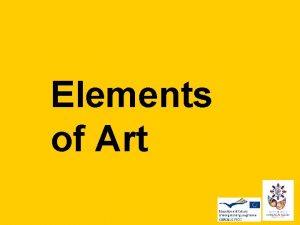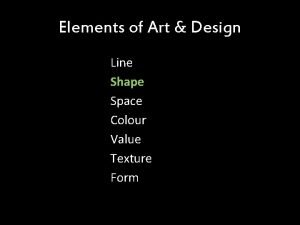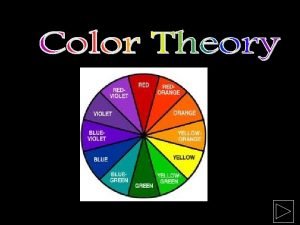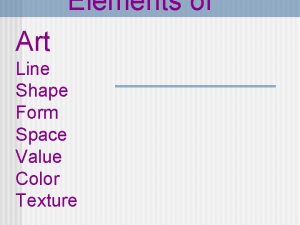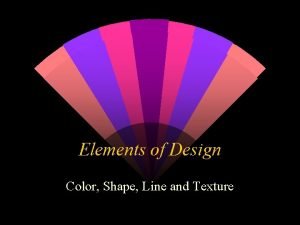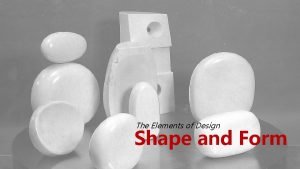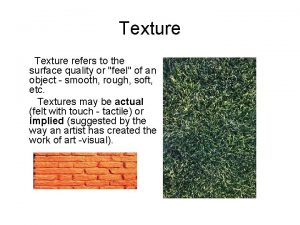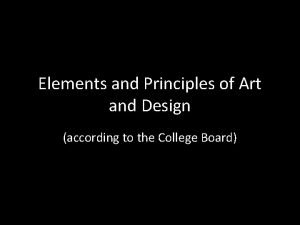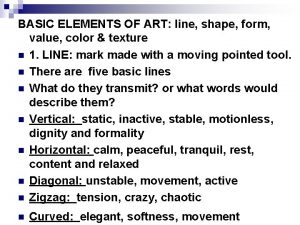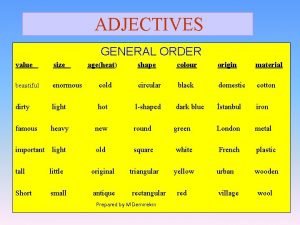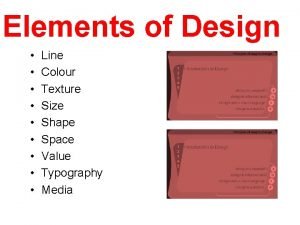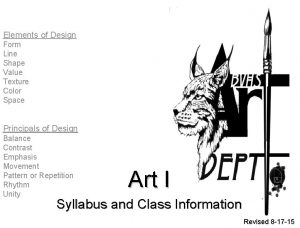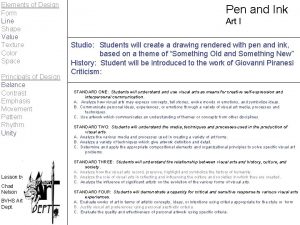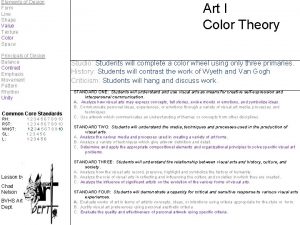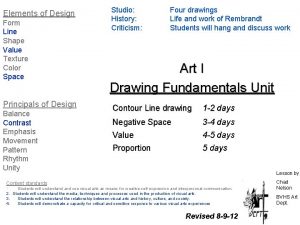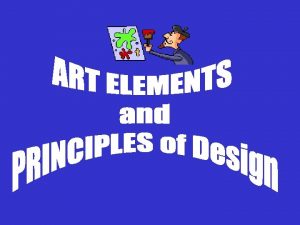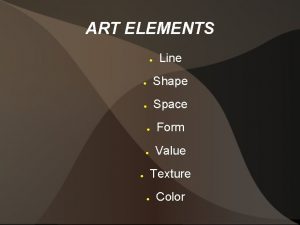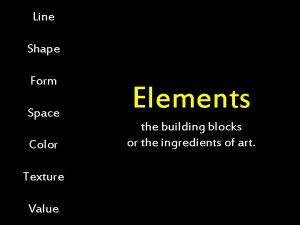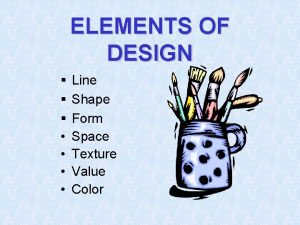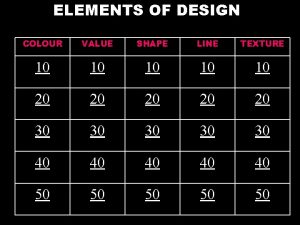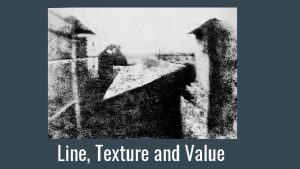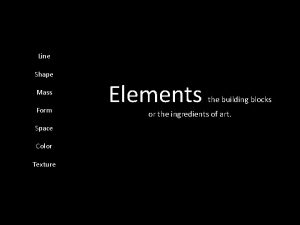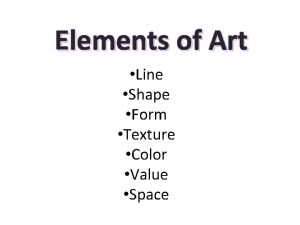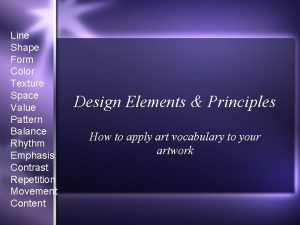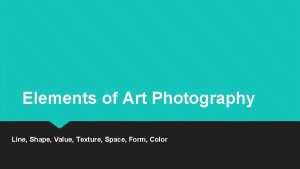Elements of Design Form Line Shape Value Texture















- Slides: 15

Elements of Design Form Line Shape Value Texture Color Space Principals of Design Balance Contrast Emphasis Movement Pattern Rhythm Unity Lesson by Chad Nelson BVHS Art Dept. Watercolor Still Life Art I Studio: Students will draw and paint a still life emphasizing the techniques and tools: muting with complementary color, clock tool Mondrian lines, and unit of measurement History: Still life work of Cezanne and Work of Mondrian Criticism: Hang work and discuss upon completion of project STANDARD ONE: Students will understand use visual arts as means for creative self-expression and interpersonal communication. A. Analyze how visual arts may express concepts, tell stories, evoke moods or emotions, and symbolize ideas. B. Communicate personal ideas, experiences, or emotions through a variety of visual art media, processes and techniques. C. Use artwork which communicates an understanding of themes or concepts from other disciplines. STANDARD TWO: Students will understand the media, techniques and processes used in the production of visual arts. A. Analyze the various media and processes used in creating a variety of art forms. B. Analyze a variety of techniques which give artwork definition and detail. C. Determine and apply the appropriate compositional elements and organizational principles to solve specific visual art problems. STANDARD THREE: Students will understand the relationship between visual arts and history, culture, and society. A. Analyze how the visual arts record, preserve, highlight and symbolize the history of humanity. B. Analyze the role of visual arts in reflecting and influencing the culture and societies in which they are created. C. Analyze the influence of significant artists on the evolution of the various forms of visual arts. STANDARD FOUR: Students will demonstrate a capacity for critical and sensitive response to various visual arts experiences. A. Evaluate works of art in terms of artistic concepts, ideas, or intentions using criteria appropriate for the style or form. B. Justify visual art preferences using personal aesthetic criteria. C. Evaluate the quality and effectiveness of personal artwork using specific criteria.

Clock Tool Drawing tool used to check angles of subject matter and match them with the face of the clock. The same clock position can then be transferred to the drawing. Tools of Proportion Comparison of the elements, in terms of their properties of size, quantity, and degree of emphasis.

Mondrian was an important contributor to the De Stijl art movement. Despite being wellknown, often-parodied and even trivialized, Mondrian's paintings exhibit a complexity that belies their apparent simplicity. He is best known for his non-representational paintings that he called compositions, consisting of rectangular forms of red, yellow, blue or black, separated by thick, black rectilinear lines. They are the result of a stylistic evolution that occurred over the course of nearly 30 years and continued beyond that point to the end of his life.

Mondrian Lines Drawing tool used to align a straight edge with elements of the subject matter to attain proportion. Tools of Proportion

Unit of Measurement Comparing an element of the subject matter to other elements to establish Proportion. Tools of Proportion

Negative Space Drawing Definition: Negative space is the void area between objects in a drawing. Purpose: Drawing the space around objects is another very helpful way for artists to break down an image into shapes and eliminate schemas.

Paul Cézanne (January 19, 1839 – October 22, 1906) was a French artist, a Post. Impressionist painter. Cézanne can be said to form the bridge between late 19 th century Impressionism and the early 20 th century's new line of artistic enquiry, Cubism. The line attributed to both Matisse and Picasso that Cézanne ". . . is the father of us all. . . " cannot be easily dismissed. Cézanne's work demonstrates a mastery of design, color, composition and draftsmanship. . Using planes of color and small brushstrokes that build up to form complex fields, at once both a direct expression of the sensations of the observing eye and an abstraction from observed nature, Cézanne's paintings convey intense study of his subjects, a searching gaze and a dogged struggle to deal with the complexity of human visual perception.








References Drawing from Observation by Brian Curtis Art Fundamentals Theory and practice by Otto Ocvirk
 The spectrum bent into a circle
The spectrum bent into a circle Polygon drawing line color value texture shape space form
Polygon drawing line color value texture shape space form Form shape and space
Form shape and space Line form shape and size
Line form shape and size Elements and principles of design matrix examples
Elements and principles of design matrix examples Line color and texture
Line color and texture Shape and form
Shape and form It refers to the surface quality or feel of an object
It refers to the surface quality or feel of an object Contoh value creation adalah
Contoh value creation adalah Principles of art
Principles of art The basic element of art
The basic element of art A feeling of visual equality in shape form value color etc
A feeling of visual equality in shape form value color etc Size shape age color
Size shape age color Shape color size texture
Shape color size texture Shell cleanliness shell soundness shell
Shell cleanliness shell soundness shell Egg parts diagram
Egg parts diagram
